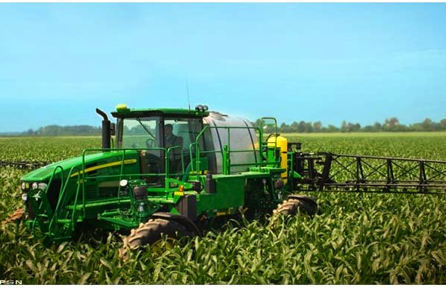Deere Brings Self-Propelled Tractor Spraying Technology To New Levels of Precision – and Profit
John Deere’s latest self-propelled tractor spray systems bring total control to the formerly “spray-everything” world of chemical coverage. By using full electrical control down to each nozzle, together with global positioning system (GPS) monitors, the new sprayers put chemicals exactly where they are needed.
Spraying the Right Chemical for the Right Crop
For example, if a farmer wants to cover a certain section of crops with an anti-fungal agent, while another section needs micro-nutrients coverage, the Deere R4030 or R4038 Spray systems can shut off the anti-fungal nozzles and switch to micro-nutrients automatically. The GPS system can control the exact timing based on defined locations of the tractor along the specific crops.
Deere also has the faster, easier, safer features covered. There are optional separate on-board mixing tanks that can deliver over 135 gallons of specialty chemicals into the main 800 or 1000 gallon tanks. Mixing chemicals within the automatic on-board system prevents operator snafus that could result in spills or improper mixing proportions.
High Flow Rates on Fast Tractors Bring Higher Profits
With capability for delivering over 225 gallons per minute, these self-propelled tractor sprayer systems can cover any size farm in short order. Almost any farm can now benefit from using a spraying system.
The cost savings comes from using precise amounts of spray for covering exactly the crop areas that need it. “Automatic sprayers can even pay for themselves for 1500-3000 acre farms” according to Apache Spray Systems Marketing Mgr, Charlie May.
Tractor Technology Matches New Sprayer Technology
Other key features of the new John Deere R4030 and R4038 tractor spray systems include:
-Optional front connections for loading chemicals. Front loading is faster and safer because the tractor driver can see exactly where to locate the input nozzle, without having to reverse the tractor.
-High powered suction pumps with programmable loading profiles from the loading tank. Instead of having to manually meter the correct amount of each chemical, the tractor operator punches in a crop code, or similar code for chemical loading, and the electronics take over. Only the correct amount of chemical will be released from the loading tank into the sprayer. Any additional chemicals are called out for the operator to load, and the final amount of chemicals used can be recorded for adding to the cost of particular crops. All of these steps happen automatically.
-High Precision Nozzles: Technozzlegy is how Deere phrases this precise level of chemical spraying. Each spray head can have several air induction nozzles attached to it. There may be five or six nozzles, each color coded for specific patterns, chemicals, flow rates, or areas of coverage. They can be automatically turned off and on, guided, and aimed for precise spraying of crops at specific points. Two key advantages of this system include higher possible flow rates and complete control over the areas sprayed. Both advantages are designed to save a farmer money.
Farmers using Deere’s lastest self-propelled tractor sprayers will have less to worry about when it comes to how efficiently they are spraying. Almost every drop of fertilizer or chemicals can now be accounted for exactly where they are needed.



